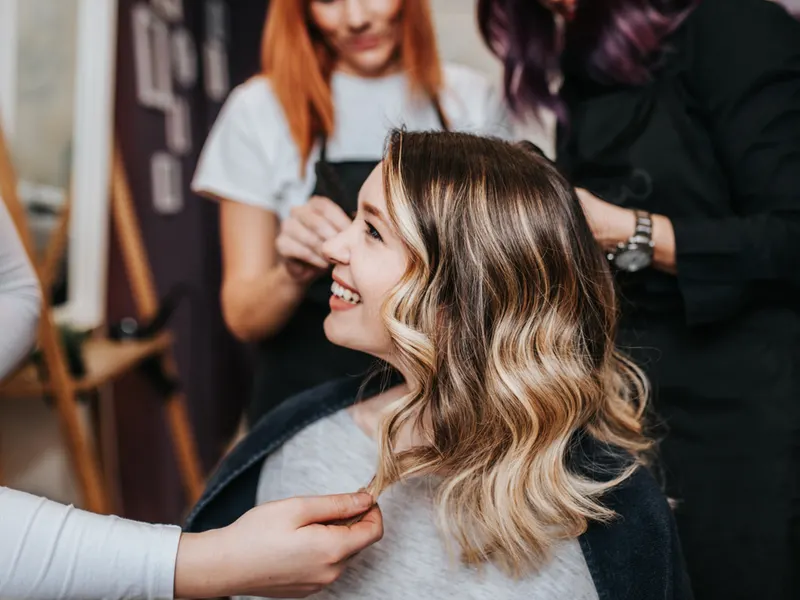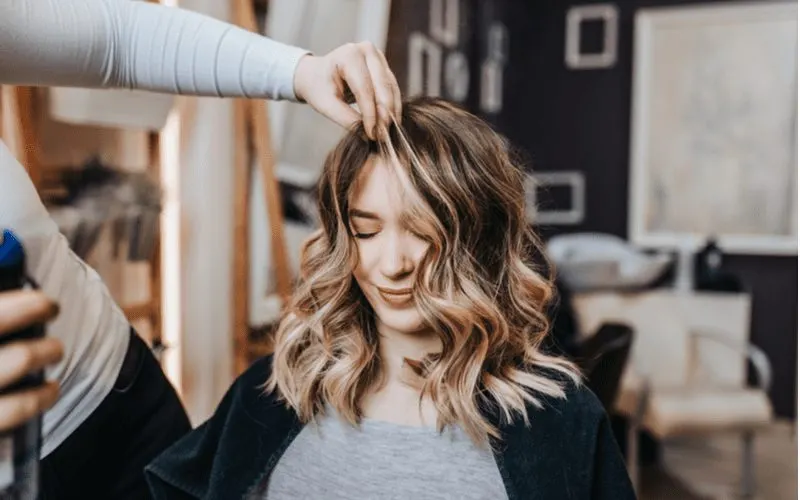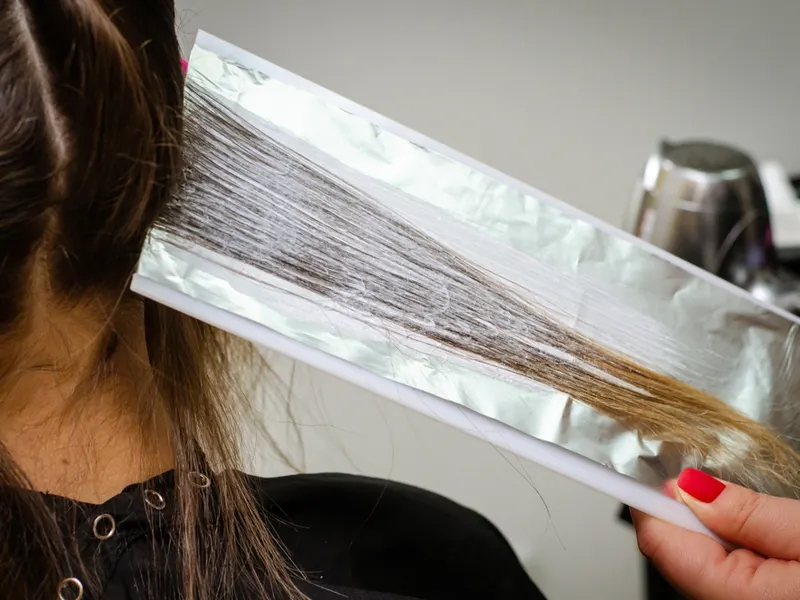Jump to:
If you want to give your hair a beautiful boost, full or partial balayage might just be the way to do it. Balayage gives you a more subtle and natural-looking color and definition.
It’s also one of the most popular alternative to highlights. Understanding the differences between full and partial balayage can help you determine which one is right for you.
The Differences Between Full and Partial Balayage
Full and partial balayage are popular ways to give your hair some dimension without looking like you’ve had a complete set of highlights. Although the technique is not new, it’s recently gained lots of popularity thanks to celebrities like Jessica Alba, Jennifer Lopez, and Halle Berry.
Although both full and partial balayage have their benefits, it’s good to understand what each one brings to the table, although there are some common upsides to both options.
These include:
- Multi-dimensional and natural-looking hair
- More minor damage than traditional highlights
- Easily customized hair treatments
If you’re new to the balayage technique, or are reluctant to dye your hair in any way, you might want to start with a partial balayage, which will still give you plenty of layering.
On the other hand, if you’ve dyed or highlighted your hair in the past and would like a fresh, updated alternative, try out full balayage.
You Might Also Like:
What Is Full Balayage?

hedgehog94/Shutterstock
Although balayage is not the same as traditional highlights, we can use similar terminology to talk about both. Full balayage refers to a technique where your hairdresser paints balayage highlights all over your head.
And it’s similar to getting a full head of traditional highlights. As a result, your locks will look a whole lot lighter, and people will notice the difference.
Benefits of Full Balayage
Although you’ll get noticeable results from full balayage, it will still be subtle enough not to look too “done.”
In addition, since your technician paints on balayage highlights rather than wrapping your locks in foil, they have a lot more creative control over your hair and can make subtle tweaks that suit your hairstyle and texture perfectly.
The results are natural, never over-processed, and very gentle. Full balayage is excellent for people who want to go a few shades lighter, look sun-kissed, or are trying to cover their gray roots between salon visits.
Since your hairstylist can choose where to apply the balayage highlights, they can select and neutralize gray locks, blending them beautifully with your natural hair. Full balayage is also excellent for people who don’t want to make multiple trips to the salon.
After all, hair highlights can be very expensive. And since it’s more subtle, it grows out nicely without looking harsh or sloppy.
Depending on your look and how fast your hair grows out, you might be able to go for several months before getting a touch-up. Full balayage looks great and can save you some serious money in the long run.
What Is Partial Balayage?

Hedgehog94/Shutterstock
Partial balayage uses the same techniques as full balayage, except instead of your hairdresser covering your whole head with balayage highlights, they only cover part of it.
People who get partial balayage generally get subtle highlights around their face or the top part of their crown, although you can sit down with your hairdresser for a consultation to see what’s right for you.
Partial balayage tends to be a bit more subtle than full balayage, and people might not notice the results right off the bat.
Instead, your skin will just look fresher, and your hair will look thicker, healthier, and more multi-dimensional after a treatment. Partial balayage is excellent for those who want to target grays or are looking for a subtle way to take their look to the next level.
Benefits of Partial Balayage
Since partial balayage isn’t as dramatic as full balayage, it’s great for people who are nervous about coloring their hair. It’s also a fantastic way to look like you’ve just spent a little bit of time in the tropics without changing your hair dramatically.
As with full balayage, the paint-on method of partial balayage will not damage your hair like traditional highlights. It also tends to be less expensive than full balayage. If you’re not sure if balayage is for you, partial balayage is a good way to test the waters and possibly upgrade in the future.
As with full balayage, partial balayage is super low maintenance. You don’t need to visit the salon as often as you would with traditional highlights and even less frequently than you would with full balayage.
Difference Between Highlights and Balayage
Although it might seem like highlights and balayage are the same thing at first, there are essential differences between the two. Balayage can give you a much more subtle color than highlights, and the balayage technique is much gentler.
This quality means that balayage is suitable for damaged or over-processed hair and can yield much healthier results.
Since your hairdresser paints on balayage, instead of using highlight foils, they have a lot more creative control over the end result and can customize the look to suit your personal preferences.
Less Damage
If you love the look of highlights but don’t like the damage that your hair undergoes, as a result, balayage is definitely for you.
The paint-on process is far less damaging to hair overall since your hair technician gently applies the formula rather than soaking your locks in bleach and wrapping them in foil. As a result, your hair will look and feel less damaged.
Totally Customizable
One of the key reasons celebrities love balayage so much is that it’s completely customizable. Your hairstylist can give you plenty of options based on your preferences, budget, and personal style. You can even combine balayage with other different styles and techniques to achieve a unique and classic look.
Infrequent Touch-Ups
Balayage is your new best friend if you want a salon-style look that doesn’t require the heavy maintenance of regular highlights (like getting root bumps).
You can go twice or three times as long without coming in for a touch-up, depending on how much balayage you have in your hair and how quickly your hair grows in.
Frequently Asked Questions

Tetiana Tychynska/Shutterstock
Although balayage has been around since the 1990s, it’s now peaking in popularity, so you’ll naturally have some questions. These commonly frequently asked questions and answers will help you get the perfect balayage for you and your style.
Is It Good for Every Hair Type?
Balayage’s gentle formula and innovative application make it perfect for virtually any and every hair type. Your hairdresser can also customize the shade of balayage they use and add in different thicknesses to complement and highlight curly, straight, or wavy hair.
Balayage does look best on hair that’s at least chin-length, though, because it’s subtle and will not show up as well in very short hair.
How Long Does It Take?
Another key upside to getting balayage rather than traditional highlights is that it’s a much faster process. Depending on how much balayage you’re getting, expect to be in the salon chair for about an hour or so.
If you’re getting several different shades of balayage, or if you’re going significantly lighter, it might take a little bit longer. Talk to your salon professional for details and insight into your personal situation.
Is Balayage the Same as Ombre?
Ombre and balayage are not the same things; The ombre effect is when your hair gradually goes from dark to light or vice versa. It’s a gradual but apparent vertical change.
On the other hand, balayage gives you a fully incorporated, blended, and multi-dimensional head of hair. Although there are differentiations in color, it’s not the dramatic dark-to-light look you get with ombre.
It is, however, possible to achieve an ombre style and have balayage at the same time. Simply ask your hairdresser to start your full balayage slightly lower on your head so that your roots show on top.
What Are Popular Types of Balayage?
Although full and partial balayage are the two most popular and dominant styles of balayage, there are some specific things that you can ask for in addition to full and partial treatments.
One of the most popular is babylights. Babylights are very thin strips of balayage designed to give you subtle dimensions and a boost around your face.
How Does My Hairdresser Apply Balayage?
Your hairdresser will paint on balayage rather than wrapping your locks in foils. This process tends to be far gentler on your hair, as the bleach solution will not saturate your strands as it would with foils.
It also gives your hairdresser a lot more freedom to work with your hair texture, face shape, and hair color for a custom look that suits you perfectly.
Full vs. Partial Balayage: Final Thoughts
There are a few differences between full and partial balayage, but these two treatments are very similar at their core.
The most significant difference between the two is that full balayage gives you a complete head of highlights, whereas partial balayage gives you strategic highlights and tends to be less costly and drastic in the end.
